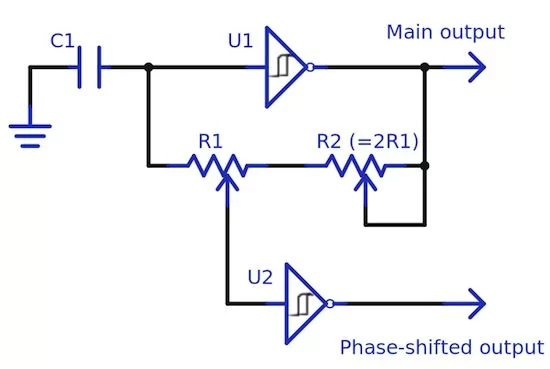This Design Idea demonstrates a simple way to generate a multiphase clock signal, the frequency of which can be varied with minimal change in phase shift(s).
The phase shift of the second output can be tuned from near zero to 180° without affecting the frequency. The basic circuit uses a minimum of parts: one cap, two resistors, plus two Schmitt triggers.
Frequency is a function of C1 and the sum of R1 and R2. U2 provides the phase shifted output – which leads the master output of U1– via the tap on variable resistor R1. When the output of U1 is high and C1 is charging up, the voltage at the input to U2 will be higher than the voltage at the input to U1; therefore U2 will change state before U1, creating a phase lead. When U1’s output is low, the input to U2 will be lower than U1’s input, and it will again trigger ahead of U1. The closer the wiper of R1 is to R2, the greater the phase lead.
With CMOS Schmitt triggers, the input thresholds are not perfectly symmetrical relative to the output, and the two phase shifts will not be equal. This asymmetry is particularly noticeable with small phase leads.
R1 controls the phase shift, and R2 can be varied to trim the frequency (since this will alter phase, you should trim frequency, then phase). I show variable resistors in the schematic, but you can make one or both fixed; or, make R1 and R2 a single variable resistor, giving no frequency adjustment and a restricted adjustment range.
For more detail: Add phases to simple RC oscillator

